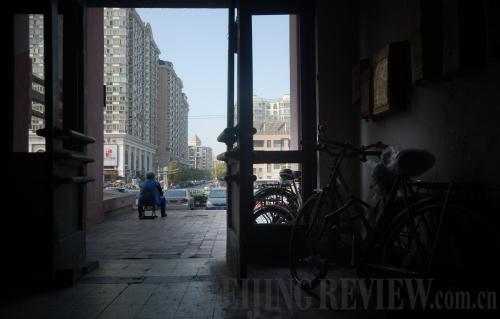|
 |
|
LOOKING TO THE FUTURE: An elderly resident of the Anhua Building sits in front of its gates and stares at newly built residential buildings (WEI YAO) |
As the Anhua Building's rent, 10 yuan for one two-bedroom apartment, was much higher than at other government-supplied housing complexes, the building did not find enough tenants until five years after its completion. It was not unusual for two families to share one two-bedroom apartment since neither family could afford the rent alone.
Once the capital's best-equipped residential complex, the 41-year-old Anhua Building has long outlived the glory days.
As the building aged and skyscrapers with more spacious and better-designed accommodation sprung up across Beijing, wealthier tenants began to move out.
"These people were not high-level professionals like me but they were better at making money," said Xu Qinmin, who has lived in the Anhua Building since 1960. He used to be the manager of a state-owned switchgear factory.
In 2002, Cala, My Dog!, a comedy that depicts the bond of a struggling Beijing man and his pet, was partly filmed in the Anhua Building. But this moment in the spotlight failed to boost the morale of the tenants. "The film was shot here simply because it was crumbling," said Li Xiumei, who has lived in this building for decades.
Today the building's long hallways, stuffed with discarded pieces of old furniture and garbage, are too narrow, at many points, to allow only two people to walk abreast.
A striking sign on the exterior wall says, "For safety sake, please stay away from the wall."
"When my daughter was young, she often told her classmates proudly that she lived here; now my granddaughter is too embarrassed to invite anyone of her school friends home," Wang said.
Today, young tenants are dying to move out as soon as they receive a pay rise. The mainly elderly residents of the now ramshackle apartment block are eagerly awaiting the announcement of a demolition and relocation plan.
The lack of an individual kitchen for each apartment has been considered a critical design flaw and a major cause for complaints ever since tenants moved in.
Xu recalled that the earliest tenants used to cook their meals on coal stoves in the corridors.
"Everyone had to walk through the hallways with a hunched back to avoid being choked by smoke from stoves, like escaping during a fire," Xu said.
Xu and his neighbors lived with the smoke and fire hazard posed by the individual stoves until 1964 when the administration of the building opened three shared kitchens on each floor, equipped with gas stoves. Under the new design, households sharing one kitchen also shared the water bill, which was charged on the only water meter, and took turns to clean up the kitchen.
The collective kitchens became unsustainable in the 1980s. Neighbors no longer trusted each other as they lost their cookware or even dishes on stoves to petty thieves. The rotating clean-up scheme was discarded. Some people even used water from the kitchen faucets to wash their clothes in order to get maximum value from their shared bills.
In 2008, the administration of the building was forced to remodel the shared kitchens and install individual faucets and water meters for each family. However, it wasn't long before tenants began to put locks on and even dismantle their faucets so that their water wouldn't be used unauthorized.
Moreover, the shared kitchens have never been fitted with ventilation systems, leaving the ceilings and walls orange from years of smoke. "The kitchens in the building are much filthier than one could imagine," Xu complained.
Refusing to step onto grimy kitchen floors, young tenants prefer to cook with electric stoves in their own apartments.
"I wouldn't call the design unrealistic. It was simply way ahead of its time," said Jin, who considers "encouraging communal life while respecting the freedom of individual families" the building's guiding design principle. | 